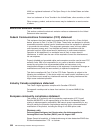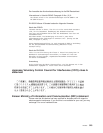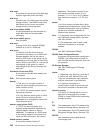A
access
1) To obtain the use of a computer
resource.
2) In computer security, a specific type of
interaction between a subject and an
object that results in flow of information
from one to the other.
access-any mode
One of the two access modes that can be
set for the storage unit during initial
configuration. It enables all
fibre-channel-attached host systems with
no defined access profile to access all
logical volumes on the storage unit. With a
profile defined in DS Storage Manager for
a particular host, that host has access
only to volumes that are assigned to the
WWPN for that host. See also pseudo
host and worldwide port name.
ACK See request for acknowledgment and
acknowledgment.
agent A program that automatically performs
some service without user intervention or
on a regular schedule. See also subagent.
alert A message or log that a storage unit
generates as the result of error event
collection and analysis. An alert indicates
that a service action is required.
allegiance
For zSeries, a relationship that is created
between a device and one or more
channel paths during the processing of
certain conditions. See also implicit
allegiance, contingent allegiance, and
reserved allegiance.
allocated storage
The space that is allocated to volumes but
not yet assigned. Contrast with assigned
storage.
American National Standards Institute (ANSI)
An organization of producers, consumers,
and general interest groups that
establishes the procedures by which
accredited organizations create and
maintain voluntary industry standards in
the United States. (A)
Anonymous
In the DS Storage Manager, the label on
an icon that represents all connections
that are using fibre-channel adapters
between the storage unit and hosts but
are not completely defined to the storage
unit. See also anonymous host, pseudo
host, and access-any mode.
anonymous host
Synonym for pseudo host. Contrast with
Anonymous and pseudo host.
ANSI See American National Standards
Institute.
APAR See authorized program analysis report.
(GC)
API See application programming interface.
application programming interface
An interface that allows an application
program that is written in a high-level
language to use specific data or functions
of the operating system or another
program.
arbitrated loop
A fibre-channel topology that enables the
interconnection of a set of nodes. See
also point-to-point connection and
switched fabric.
array An ordered collection, or group, of
physical devices (disk drive modules) that
is used to define logical volumes or
devices. In the storage unit, an array is a
group of disks that the user designates to
be managed by the RAID technique. See
also redundant array of independent disks.
ASCII (American National Standard Code for
Information Interchange) The standard
code, using a coded character set
consisting of 7-bit coded characters (8 bits
including parity check), that is used for
information interchange among data
processing systems, data communication
systems, and associated equipment. The
ASCII set consists of control characters
and graphic characters. (A) Some
organizations, including IBM, have used
the parity bit to expand the basic code set.
assigned storage
The space that is allocated to a volume
and that is assigned to a port.
authorized program analysis report (APAR)
A request for correction of a defect in a
current release of an IBM-supplied
program. (GC)
326 IBM TotalStorage DS8000: Messages Reference


















